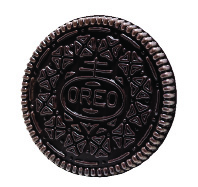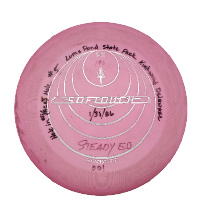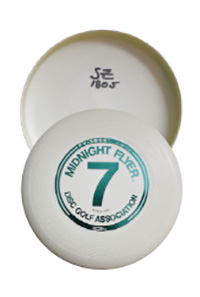Favorite Flyers: Collecting the Discs We Threw
Favorite Flyers: Collecting the Discs We Threw
Dan "Stork" Roddick Reassess His Collection

(This article first appeared in the Fall 2020 Issue of DiscGolfer Magazine.)
Collecting things is an odd quirk of human nature. I like to think that we were in our most natural state during the hunting and gathering period. The more we’re like those guys, the happier we would be. And what were they gathering? Not collectibles, that’s for sure. Why? Because they were lucky to just barely stay alive, and they were continually moving with the seasons and their quarry. It was hard enough to drag their essential stuff along, let alone a collection of pretty rocks. Maybe there were a few such strange souls, but they were slowed down by the weight of unnecessary stuff. Eventually they fell behind the tribe and were eaten, thus leaving the gene pool.
The intentional collection (and cataloging) of things that we don’t really need to survive is a clear sign that we have lost connection with the purpose of our possessions. Stamps are to mail letters. Coins are for vending machines and discs are for throwing. Just sayin’…Well then, fact is that you’re a collector. No shame in that, but it’s worth recognizing and also realizing that it’s the kind of thing that can easily get out of control. You don’t even think of it as a problem now, and maybe it isn’t, but that’s how everyone starts out. Those things you got free at Worlds are like the ‘free’ samples that drug pushers give out to get new customers. It sneaks up on you. It’s all fun and games and soon you’re running out of wall space, renting storage units, and your marriage is getting rocky. Just sayin’…
Managing the Problem
Back in 1979, I wrote an article on collecting for Frisbee World Magazine. My contention at the time was that the only way to make any sense of this odd habit was to settle on some sort of specialty. Translation: Willingness to collect any and every plastic disc is obviously madness. People have been institutionalized for such compulsive behavior. However, having a collection of discs carrying a stamp from different U.S. states is a hobby that anyone can understand, appreciate and perhaps even envy. Think about it: There are lots of fun possibilities. With discipline, it can be a closed set. Only fifty discs to find. You’re just looking for the most interesting example you can find from each state. If you have a fairly mundane disc for Kansas and you come upon a really cool four-color stamp that includes a Jayhawk, you make the switch and you have one to trade.
Got a big wall to fill? Outline a giant map of the U.S. and as you acquire each disc, hang it in its state. The map will virtually beg to be completed. Friends and relatives will visit and marvel. They will also want to help out when they travel by looking for the ones you still need. Want to make it more challenging? Maybe you even want to join the club of folks who have played disc golf in each of the states. Or go for only golf discs, or only one brand or only one color. Have an even bigger wall? Then add the Canadian provinces and Mexican states. A logical extension (for other rooms) is adding other countries as well. Sure, you need a bigger place, but you’re still not a candidate for the Hoarders TV series because your specialty definition clearly explains the limits of your quest. And anyone can fully understand what you’re doing. No family court would remove child custody from a person with a perfectly reasonable specialty.
So, anyway … over those forty years since that article, I’ve had a lot of plastic go through my hands. At the peak, I probably had about 20,000 discs on the property. I know, it sounds excessive, but I never lost custody (or at least visitation) of my children because virtually all of the discs were in carefully-defined specialties. I had examples of all the World Frisbee Championship (WFC) items, which was almost cheating because I had overseen all of those events. I had a ton of glow-in-the-dark discs because they made cool nightlights in bedrooms. Maybe my favorite specialty was the mimetics. It’s a term used in architecture for buildings designed to look like other objects. The ice cream store in Mims, Florida is one of my favorites, for several obvious reasons.
Mimetic disc collecting sends you out looking for such cool flyers as the Sailing Sombrero, the Flying Cow Chip, lots of cute animals as well as many flying coins and bottle caps. At the peak, I think I had about 50. It’s a collection that’s fun to show your muggle friends. Even Grandma can appreciate a disc that looks like a tasty Oreo cookie.

You can see a good selection of mimetic discs and many other collectibles at the Flying Disc Museum. These virtual galleries are a rich, and growing resource, directed by Mike Hughes.
Fewer Discs … More Joy
Over the years, driven by a desire to cut back on my possessions in general, I’ve begun to whittle down my collections. But I’m still keen to collect some discs, so what’s a fellow to do? My solution has been to find a new specialty that works best with this (late) stage of my life. And that’s what I want to share with you, hoping that you might enjoy it as well.
I wanted to have a collection that could be kept to a reasonable number, and provide a particularly intense joy of ownership (thanks, Marie Kondo).
And that led me to an area that is a red-hot sector of other sports memorabilia — game-used items. If you follow such sweat equity markets, you may know some of the crazy prices that such gear commands. There may still be a pair of LeBron’s signed game shoes available for (brace yourself) $30,000 dollars. Other similar items have equally eye-popping prices.
The School of Hard Nicks and Scratches
In our world, I’m focusing on discs that have actually been in play. Ideally, they’ve been in play a lot. Of course, this goes counter to almost all other collecting. Typically, value is very much tied to condition. A buffalo nickel (or a Pluto Platter) can go from almost worthless to almost priceless, based on its condition. With this specialty, I have the contrarian view. I want the disc to show the length and depth of its use. In his classic treatise, Frisbee (1975), Dr. Stancil Johnson, assures us that “Frisbee play joins man’s greatest tool, his hand, with his greatest dream, to fly.” That tells the story of the connection. And you can see it reflected in the plastic. Take a look at your favorite discs that have been with you through thick and thin. Well-used discs get that certain patina that is distinctive. The earth and the turf and the trees have all left their marks. A long-used putter even starts to carry a silvery gloss from the chains of the basket. Hey, no matter what, we all make that final putt!
Over time, a person gets invested in the objects that we count on. I keep a good many of PapaJack’s favorite workshop tools, because they were a part of him. And I treasure having his favorite flyers for the same reason. He has his blood, sweat and tears invested in each of them.
Now, this isn’t necessarily true for all other sports. Few players keep a favorite table tennis or bolf ball for too long. Those objects are simply commodities that get quickly replaced.
That’s where our discs get even more interesting to me. Almost always, we write on our discs to identify them as our own, both as required by the rules of play and in the hope that a wayward flyer will find its way back home to us. So each of these long-used aircraft not only carry the scars of its battles, but also the branding of its pilot.

Nate Doss and Paul McBeth autograph discs before a 'Meet the Pros' event in 2015. Photo: PDGA
Very Cool, But Not For Me
Now, I should mention a close cousin of this specialty … and that is autographed discs. I’ve got a few of those. Remember, I did have 20,000. But they’re a very different proposition for me. For one, I always think it’s a bit of an odd imposition to ask anyone to sign anything. Not that I mind doing it myself. It happens rarely enough that I’m still flattered. Bill Nye is pretty much over that. To me, an autograph on a disc is just … an autograph. I know, I know, there’s probably a ton more autograph collectors than there are flying disc collectors. But that’s just another easily-disregarded fact. As I hope you’ve come to see, my attraction to these well-played discs is a much different thing. But, you say, “What about those borderline cases?” Sally Struthers was the celebrity queen of the 1976 World Frisbee Championships at the Rose Bowl. Of course, she signed a few discs.
Sally Struthers Disc
Now don’t get me wrong, Murph (and Sally), this is a great collecting item, especially for a WFC collector or a fan of All in the Family. It just doesn’t make it into my collection. Why? Because even though Sally was part of that event, she wasn’t part of that particular disc. Same goes for a player signature, even on a significant event disc. Eagle’s signature on the 2018 Las Vegas Challenge disc? Again, a great disc to have, but what I want is his putter. That is part of how he won.
Fun to Show AND to Throw!
So, you get the idea, and my slowly-growing collection isn’t all luminaries and champions, although I love getting those. Who wouldn’t want a playing disc that knew the hands of Steady Ed, or Climo or McBeth? Those are “oooh, ahhhh” pieces in any such collection. But for most of us, I think that playing discs from friends, current, past or departed, end up meaning a great deal. When I hold one of those discs in my hands, or even throw them, I feel that strong connection with the original owner. And yes, these collector items can still be thrown. No pristine hermetically-bagged beauties are these. Give that mint Pluto Platter a few tosses and you can almost hear its value flying away.
And these discs can be valuable, especially as collectors come to appreciate the unusual appeal. It’s worth remembering that in the past, such discs have been literally at the bottom of the barrel. Every player has a good many discs that served their time as mainstays of the bag, but then, for various reasons, they got replaced. Maybe new technology threw shade on their performance. That Valkyrie that was the prime driver just lost out to the newer, faster kid on the block. Or, a disc had seen so much service that it simply got too flippy for your increasingly powerful release. There’s only room for so many discs in the bag. So, almost every player has that stack of former favorites. And that’s exactly what I’m looking for. There’s definitely a supply of them out there to be acquired. Finding value in previously unwanted things is a win-win, I’d say.

Big Bucks for a Piece of Our History
And, speaking of value, there recently was a high-profile sale, involving this sort of disc that went down in an auction on the Flying Disc Collectors Consortium, a Facebook group of about 1500 enthusiasts, led by Gary Perlberg. Scott Zimmerman is the most decorated overall player of all time (see his biography, as reviewed by Billy Bloom in the Summer DiscGolfer). Scott posted that he was offering some of his very historic playing discs for sale. The most compelling item was the 182 gram Midnight Flyer that he used to win golf on his way to the overall title at WFC ‘82 (Rutgers).
After a round of spirited bidding, Billie Ashton, an avid collector and photographer from Minnesota, placed the winning bid of $800, which won her Scott’s winning disc, a pristine backup and the event trophy, which Scott added to the deal.
So, Think About It
I hope that this is something you will consider, even if you only keep a few special, and meaningful veterans of play. It’s easy to get started by just asking friends (or your favorite pro) to keep you in mind when they retire a playing disc.
As I think back over my life in the playing community, it’s clear that my most cherished collection is of the friends that the game has given me. It’s what we’ve come to call, the “Frisbee Family.” In my experience, that network of friends is uniquely sustaining. And, in a very tangible sense, this collection serves as a reminder of those friendships and the play that has connected us. I truly believe that these are more than just plastic discs. Each one, over time, has become an extension of its owner.
Stancil Johnson wrote that when a ball dreams, it dreams it’s a Frisbee. So then … what does a Frisbee dream?
I could be wrong about this, but I’ve come to believe that when a Frisbee dreams, it dreams of its thrower. And that’s a dream worth keeping.
Stork has been playing and designing fun and challenging things to do with flying discs for over 60 years.

